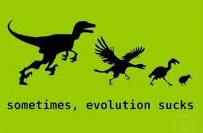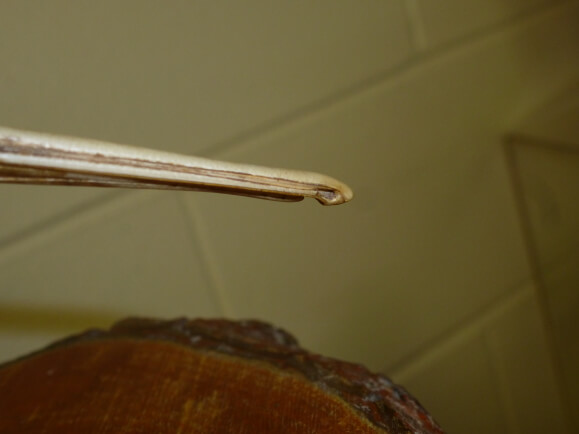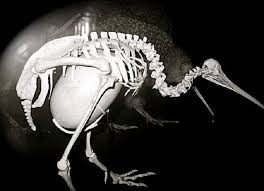BBC Earth has done it again – given us another wonderful video of native New Zealand fauna. A couple of days ago there was a special video of Tuatara hatching. This time it’s the brown kiwi.

The evolution of the kiwi. (Source: Twitter)
The kiwi of course is the endangered flightless bird New Zealanders get their nickname from.
We also gave the name to a fruit – the Chinese gooseberry (genus – actinidia). Given anti-Chinese sentiment and the fact they grow so well here, a marketing programme gave the Chinese gooseberry the name Kiwifruit when I was a kid. The name stuck and most people don’t even know about the real name.
Anyway, back to the film.
The short film shows the courtship of two birds courting and eventually mating in the wild.
Brown Kiwi Courtship Spectacle
Kiwi are nocturnal, so all the action takes place at night. The photographer nevertheless got some wonderful footage.
The film mentions the unique beak of the bird, which has the nostrils at its tip. When Jerry Coyne and I went to the Otorohanga Kiwi House and Native Bird Park a couple of months ago, he took this pic of a kiwi skeleton. It shows the nostrils at the tip of the beak.

Kiwi nostrils are at the end of the beak. (Photo credit: Jerry Coyne. Click pic to go to the post on his website that includes the pic.)
Kiwi Eggs
When the female kiwi comes to lay her eggs, she will be unaware of the unique place she holds in the bird world. Her egg is the largest in comparison to body size of any other. Once laid, the male sits on the eggs until they hatch. Then the parents share the duties of raising the chicks equally.

(Source: Reddit)
I’m not a scientist, but my assumption is that the lack of predators before human settlement (about 1300 CE) meant there was no need for wings and they grew smaller and smaller. The birds could get all nutrition foraging on the forest floor. That left more energy to devote to the production of the next generation.
We humans brought several animals that hunt and kill kiwi.* As well as dogs and cats, we brought rats, stoats, weasels, and possums. Successive governments are committed to making New Zealand predator free by 2050. Several offshore islands have that status already, and kiwi and other native birds now thrive on them.
New Zealanders generally show a strong commitment to maintaining our environment. One of the things that brings us together as a people whatever our beliefs is a pride in the beauty of our country and uniqueness of much of our flora and fauna.
Besides, it earns us a lot of money in ecotourism! 🙂
A typical video promoting New Zealand:
* There is no “s” in Māori. All nouns are both singular and plural.
If you enjoyed reading this, please consider donating a dollar or two to help keep the site going. Thank you.

The Kiwi is one of the most endearing birds. Round, fluffy, and with a cute beak. Endangered, but it’s gratifying to see that at least here on this wonderful island at the end of the world people come together in the name of the wildlife and environment – even if money plays a part. The rest of the world has something to learn from that.
Well, I have to say that I’m very disappointed, Heather. I clicked on the link expecting to see a salacious video of New Zealand people fornicating, with some dominatrix action, and instead all I get is some cute flightless birds chasing each other through the undergrowth. Talk about clickbait! 😀 😀
😀
To tell the truth, the click bait potential of the heading hadn’t occurred to me on this occasion. Which speaks volumes about my life! 😀
I might have mentioned it earlier (it is not my original idea, but I do not remember who pointed this out), but from many pov’s. kiwi’s are the most mammal-like birds we know. Poor vision, great smell, long whiskers, nocturnal, long (or at least huge) gestation, ‘hairy’ feathers, burrowing and indeed flightless. They occupy clearly a mammal-like niche in ‘mammal-less NZ’.
Their mating behaviour does not strike one as clearly mammal-like though.
Evolution may suck sometimes(:)), but the Kiwi is a clear -well, maybe not very clear- example of convergent evolution, I’d think.
I hadn’t thought of that. My knowledge of evolution is too limited to comment with authority of course, but what you say makes sense to me.
“Their mating behaviour does not strike one as clearly mammal-like though.”
It is in fact quite similar to that of wombats — the female runs away, but not quite fast enough, at least if she likes the male. The male finally gets close and bites her on the backside (they have a very thick hide), at which point she stops still…. Beyond that, I don’t know of any other mammals who do this, and will resist the temptation to make any jokes about it. (Having outed myself here as a Tasmanian, I know it would backfire.)
@Heather — I love the “evolution sucks” cartoon!
(I understand that wings have a great evolutionary cost, requiring considerable musculature, so variants that expend less on musculature prosper if flight is unnecessary. I say this as one with a diploma in reading Richard Dawkins about the dodo!)
No – basic principles from Why Evolution is True (the book). The only Richard Dawkins I’ve read is The God Delusion. I keep meaning to read The Selfish Gene, but have never got around to it. I own the first part of his autobiography, but have never got around to that either.
I usually only read books in bed these days for physical reasons I won’t bore you with, and Kindle is much easier to manage in bed. However, I don’t like reading non-fiction books electronically. It means I’m very behind in my non-fiction reading of books.
Only the ‘God Delusion’? My God, that is ‘deplorable’ ?
I recommend ‘Climbing Mount Improbable’ and ‘River out of Eden’, if you want some more ‘biological’ background (besides the Selfish Gene) and they are ‘easy’, agreeable reads.
I would not recommend ‘The Extended Phenotype’ to start with, it is his most’technical’ popular book, quite dense.
I also find Kindle doesn’t work so well for non-fiction. Sorry to hear of physical troubles — hope it’s nothing too difficult.
There’s a nice audiobook of The Ancestor’s Tale read by Dawkins. It’s about wandering back through evolutionary history and each ancestor tell a tale about evolution.
Ah yes, The Ancestors Tale. How Stupid of me not to have thought of that ?. A first year biology student’s biology course minus most of the maths.
In an audio version the many marvellous illustrations will be lost though. This is one of the few books where I would really recommend the hard cover version.
I like audiobooks. They’re good for car journeys. I don’t have many, but I might get this one. I have the paperback but haven’t read it.
The God Delusion is pure fiction (deadly dull as it is).
If you think The God Delusion is “pure fiction” you either haven’t read it or you need to check your understanding of the definition of fiction.
I meant typically mammal males copulate and ‘disappear’. It is rare, if not unheard of, that a male mammal takes a major part in raising the young. Kiwi males are brooding the egg, they even get a bald chest and ‘kiwisplain’ themselves over the egg.
Didn’t mean to come across as contrarian, if I did… Just wanted to put in a word for wombats!
I realised I had not been clear about ‘mating behaviour’, it should have been ‘post-mating behaviour’ ☺.
The Wombat’s have their pouch opening caudally, which makes sense for a digger. The question is now: is that caudal orientation derived or the other way round?I (no pun)